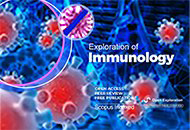
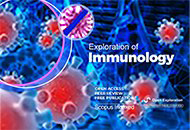
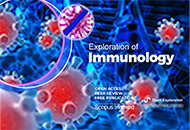
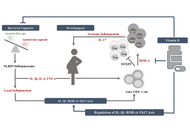
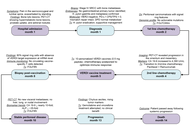
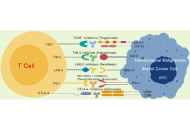
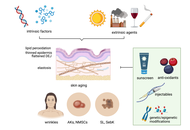
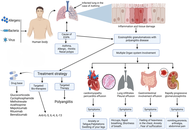
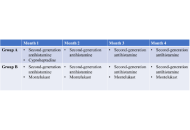
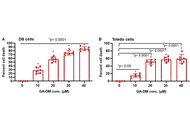
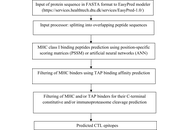
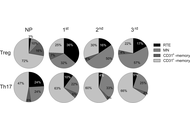
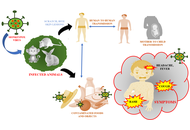
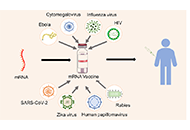
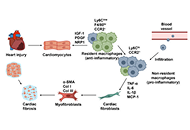
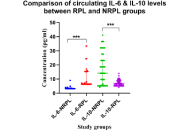
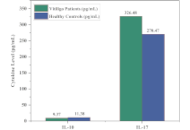




DOI: https://doi.org/10.37349/ei.2025.1003225

Cancer treatment regimens are significantly more intricate than commonly perceived. Nonetheless, both immunotherapy and chemotherapy may produce adverse consequences. Immunotherapy represents a significant advancement in the battle against cancer; nonetheless, it is not devoid of challenges. This research elucidates the mechanisms underlying immunotherapy-induced cardiovascular damage, highlighting the significant role of immune regulators, such as soluble urokinase plasminogen activator receptor (suPAR), in inducing vascular leakage. We also examine the role of matrix metalloproteinase (MMP14/15) in this process, and antigens associated with cardiovascular illness and malignancies, including native proteins, mutated tumor antigens, and viral components. Besides, we studied predictive biomarkers, such as circulating T-cell populations associated with the probability of myocarditis. We discuss treatment approaches and strategies to mitigate these issues, particularly through the use of antihypertensive medications to reduce their impact. Losartan alters the tumor microenvironment (TME) to improve immunotherapy. It restores immune effector cells in triple-negative breast cancer (TNBC), overcomes resistance in unresponsive tumors, and modifies TMEs’ immune system suppression in ovarian cancer and melanoma. It is important to note that its effects differ by cancer kind. It may promote fibrosarcoma tumor growth and improve cholangiocarcinoma treatment. This shows that losartan’s dangers in cancer treatment should be carefully considered and that more research is needed. This suggests that there must be careful consideration of the potential risks associated with losartan use in cancer treatment and underscores the requirement for additional research on this topic. This study may enhance our comprehension and management of cardiovascular adverse effects in cancer immunotherapy by integrating novel insights on immunological predictors and vascular dysfunction. Experts assert that oncology programs must provide and promote continuous monitoring of cardiac health for breast cancer patients. To mitigate the risk of cardiovascular disease in this demographic, comprehensive patient care must be administered.
Cancer treatment regimens are significantly more intricate than commonly perceived. Nonetheless, both immunotherapy and chemotherapy may produce adverse consequences. Immunotherapy represents a significant advancement in the battle against cancer; nonetheless, it is not devoid of challenges. This research elucidates the mechanisms underlying immunotherapy-induced cardiovascular damage, highlighting the significant role of immune regulators, such as soluble urokinase plasminogen activator receptor (suPAR), in inducing vascular leakage. We also examine the role of matrix metalloproteinase (MMP14/15) in this process, and antigens associated with cardiovascular illness and malignancies, including native proteins, mutated tumor antigens, and viral components. Besides, we studied predictive biomarkers, such as circulating T-cell populations associated with the probability of myocarditis. We discuss treatment approaches and strategies to mitigate these issues, particularly through the use of antihypertensive medications to reduce their impact. Losartan alters the tumor microenvironment (TME) to improve immunotherapy. It restores immune effector cells in triple-negative breast cancer (TNBC), overcomes resistance in unresponsive tumors, and modifies TMEs’ immune system suppression in ovarian cancer and melanoma. It is important to note that its effects differ by cancer kind. It may promote fibrosarcoma tumor growth and improve cholangiocarcinoma treatment. This shows that losartan’s dangers in cancer treatment should be carefully considered and that more research is needed. This suggests that there must be careful consideration of the potential risks associated with losartan use in cancer treatment and underscores the requirement for additional research on this topic. This study may enhance our comprehension and management of cardiovascular adverse effects in cancer immunotherapy by integrating novel insights on immunological predictors and vascular dysfunction. Experts assert that oncology programs must provide and promote continuous monitoring of cardiac health for breast cancer patients. To mitigate the risk of cardiovascular disease in this demographic, comprehensive patient care must be administered.
DOI: https://doi.org/10.37349/ei.2025.1003224
This article belongs to the special issue The Role of Immune Checkpoint Molecules in Cancer and Hematological Malignancies

Cutaneous lupus erythematosus (CLE) is the most common organ manifestation in individuals diagnosed with systemic lupus erythematosus (SLE). CLE can occur either alone or in association with SLE; in the latter case, it substantially increases the occurrence of disease flares and can cause disfigurement. The clinical pathogenesis of CLE is well established, as exposure to ultraviolet (UV) light and/or other environmental triggers, such as smoking or drug use, can lead to keratinocyte death in genetically susceptible individuals. This in turn activates cytotoxic T cells, plasmacytoid dendritic cells (pDCs), and B cells, creating a continuous interaction between the innate and adaptive immune systems. This interaction plays a pivotal role in CLE development, driving the formation of skin lesions. However, the molecular mechanisms underlying these cutaneous manifestations are not yet fully understood. While significant advances have been made in SLE treatment over the past few decades, U.S. Food and Drug Administration (FDA)-approved therapies remain limited to hydroxychloroquine, glucocorticoids, belimumab, and anifrolumab. Although new therapies for CLE have emerged, given the highly heterogeneous nature of the condition, personalized medicine is essential to prevent disfigurement and systemic disease flares. Understanding the molecular pathogenesis of CLE is crucial for developing targeted therapies and improving patient outcomes. This review presents current insights into CLE pathogenesis, highlighting key mechanisms driving the disease and exploring recent advances in treatments that have shown promise in clinical practice.
Cutaneous lupus erythematosus (CLE) is the most common organ manifestation in individuals diagnosed with systemic lupus erythematosus (SLE). CLE can occur either alone or in association with SLE; in the latter case, it substantially increases the occurrence of disease flares and can cause disfigurement. The clinical pathogenesis of CLE is well established, as exposure to ultraviolet (UV) light and/or other environmental triggers, such as smoking or drug use, can lead to keratinocyte death in genetically susceptible individuals. This in turn activates cytotoxic T cells, plasmacytoid dendritic cells (pDCs), and B cells, creating a continuous interaction between the innate and adaptive immune systems. This interaction plays a pivotal role in CLE development, driving the formation of skin lesions. However, the molecular mechanisms underlying these cutaneous manifestations are not yet fully understood. While significant advances have been made in SLE treatment over the past few decades, U.S. Food and Drug Administration (FDA)-approved therapies remain limited to hydroxychloroquine, glucocorticoids, belimumab, and anifrolumab. Although new therapies for CLE have emerged, given the highly heterogeneous nature of the condition, personalized medicine is essential to prevent disfigurement and systemic disease flares. Understanding the molecular pathogenesis of CLE is crucial for developing targeted therapies and improving patient outcomes. This review presents current insights into CLE pathogenesis, highlighting key mechanisms driving the disease and exploring recent advances in treatments that have shown promise in clinical practice.
DOI: https://doi.org/10.37349/ei.2025.1003222

The human vaginal microbiome plays a pivotal role in maintaining female reproductive health through its Lactobacillus-dominated microbial ecology. These bacteria contribute to the acidic pH of the vagina by producing lactic acid, ultimately preventing the colonization of pathogens. Additionally, they produce bacteriocins and hydrogen peroxide, which are detrimental to other microorganisms. Human vaginal microbiota is subjected to alterations with advancement in age, hormonal status, puberty, menstruation cycle, pregnancy and gestation, vaginal tract diseases, exposure to antibiotics, etc. Diet, lifestyle factors, obesity, and gestational diabetes are also reported to cause a shift in vaginal microbiota. This review thoroughly illustrates the perpetually changing dynamics of vaginal microbiota throughout women’s lives, as well as focuses on the impact of dysbiosis in bacterial vaginosis. More emphasis is given on immunological changes observed during bacterial vaginosis, mainly IL-1β, and its involvement in the development of preeclampsia. Thereby, this review highlights a mechanistic link between lower genital tract disease, bacterial vaginosis, and a hypertensive disorder of pregnancy, preeclampsia, via IL-1β–ROR-γt–Th17 axis, which is regulated by vitamin D, with a suggestion on how shifts in vaginal microbial community may pose a risk for preeclampsia.
The human vaginal microbiome plays a pivotal role in maintaining female reproductive health through its Lactobacillus-dominated microbial ecology. These bacteria contribute to the acidic pH of the vagina by producing lactic acid, ultimately preventing the colonization of pathogens. Additionally, they produce bacteriocins and hydrogen peroxide, which are detrimental to other microorganisms. Human vaginal microbiota is subjected to alterations with advancement in age, hormonal status, puberty, menstruation cycle, pregnancy and gestation, vaginal tract diseases, exposure to antibiotics, etc. Diet, lifestyle factors, obesity, and gestational diabetes are also reported to cause a shift in vaginal microbiota. This review thoroughly illustrates the perpetually changing dynamics of vaginal microbiota throughout women’s lives, as well as focuses on the impact of dysbiosis in bacterial vaginosis. More emphasis is given on immunological changes observed during bacterial vaginosis, mainly IL-1β, and its involvement in the development of preeclampsia. Thereby, this review highlights a mechanistic link between lower genital tract disease, bacterial vaginosis, and a hypertensive disorder of pregnancy, preeclampsia, via IL-1β–ROR-γt–Th17 axis, which is regulated by vitamin D, with a suggestion on how shifts in vaginal microbial community may pose a risk for preeclampsia.
DOI: https://doi.org/10.37349/ei.2025.1003223

T cell-based immunotherapies increasingly include personalized neoantigen vaccines that target tumor-specific mutations. However, despite their promise, current neoantigen vaccines show limited and unpredictable clinical benefit, with T cell responses observed in only a subset of patients. To overcome these limitations, we developed the VERDI (Vaccine Epitopes Ranked by Digital Intelligence) System—a cloud-based computational platform that integrates a patient’s human leukocyte antigen (HLA) class I and II genotype with selected tumor-associated antigens (TAAs), including cancer-testis antigens (CTAs), to identify peptides with high predicted immunogenicity and low risk of immune-related adverse events (irAEs). Using the VERDI System, we designed ten personalized peptide vaccines for a patient with metastatic signet ring cell carcinoma (SRCC), a rare and aggressive gastric cancer with limited treatment options. All ten VERDI vaccines were well tolerated and consistently induced tumor-specific T cell responses following a single administration, without the need for checkpoint inhibitors. The patient survived for 15 months—substantially longer than the reported median survival of 5.6 months in metastatic SRCC—highlighting the potential of this individualized, predictive vaccine platform to improve outcomes in advanced cancer.
T cell-based immunotherapies increasingly include personalized neoantigen vaccines that target tumor-specific mutations. However, despite their promise, current neoantigen vaccines show limited and unpredictable clinical benefit, with T cell responses observed in only a subset of patients. To overcome these limitations, we developed the VERDI (Vaccine Epitopes Ranked by Digital Intelligence) System—a cloud-based computational platform that integrates a patient’s human leukocyte antigen (HLA) class I and II genotype with selected tumor-associated antigens (TAAs), including cancer-testis antigens (CTAs), to identify peptides with high predicted immunogenicity and low risk of immune-related adverse events (irAEs). Using the VERDI System, we designed ten personalized peptide vaccines for a patient with metastatic signet ring cell carcinoma (SRCC), a rare and aggressive gastric cancer with limited treatment options. All ten VERDI vaccines were well tolerated and consistently induced tumor-specific T cell responses following a single administration, without the need for checkpoint inhibitors. The patient survived for 15 months—substantially longer than the reported median survival of 5.6 months in metastatic SRCC—highlighting the potential of this individualized, predictive vaccine platform to improve outcomes in advanced cancer.
DOI: https://doi.org/10.37349/ei.2025.1003221

Cancer is a multifaceted and heterogeneous disease characterized by uncontrolled growth, evasion of immune surveillance, and resistance to conventional therapies. The immune system plays a crucial role in tumor surveillance. However, tumors exploit immune checkpoint pathways to inhibit T cell activation and evade immune destruction. Immune checkpoint inhibitors (ICIs) have markedly improved outcomes in certain cancers by restoring T cell function and enhancing anti-tumor immunity. Despite these advances, the presence of immune resistance mechanisms contributes to variability in responses and ongoing challenges in overcoming resistance. Triple-negative breast cancer (TNBC), compared to other breast cancer (BC) subtypes, exhibits higher immunogenicity, but its anti-tumor immunity is profoundly suppressed by immune checkpoint molecules, creating a paradoxical scenario of “high immunogenic potential yet restrained by inhibitory signals”. Consequently, TNBC has become a significant target for ICI therapy. However, response rates vary among BC subtypes, with hormone receptor-positive (HR+) and human epidermal growth factor receptor 2-positive (HER2+) BC demonstrating lower immunogenicity. Hematological malignancies, including leukemia, lymphoma, and multiple myeloma, also exhibit distinct immune checkpoint dynamics, influencing their responsiveness to ICIs. This review comprehensively examines the mechanisms of immune checkpoint regulation, their role in cancer immune evasion, and the clinical applications of ICIs in both solid and hematological malignancies. It further discusses emerging strategies to counteract ICI resistance, such as dual checkpoint blockade, tumor microenvironment modulation, metabolic targeting, and epigenetic reprogramming. An enhanced understanding of immune checkpoint biology is essential for optimizing immunotherapy strategies and improving patient outcomes. The literature selection for this study was guided by relevance to the research topic, focusing on peer-reviewed articles, monographs, and conference proceedings published between 2010 and 2025, sourced from databases like PubMed and Google Scholar.
Cancer is a multifaceted and heterogeneous disease characterized by uncontrolled growth, evasion of immune surveillance, and resistance to conventional therapies. The immune system plays a crucial role in tumor surveillance. However, tumors exploit immune checkpoint pathways to inhibit T cell activation and evade immune destruction. Immune checkpoint inhibitors (ICIs) have markedly improved outcomes in certain cancers by restoring T cell function and enhancing anti-tumor immunity. Despite these advances, the presence of immune resistance mechanisms contributes to variability in responses and ongoing challenges in overcoming resistance. Triple-negative breast cancer (TNBC), compared to other breast cancer (BC) subtypes, exhibits higher immunogenicity, but its anti-tumor immunity is profoundly suppressed by immune checkpoint molecules, creating a paradoxical scenario of “high immunogenic potential yet restrained by inhibitory signals”. Consequently, TNBC has become a significant target for ICI therapy. However, response rates vary among BC subtypes, with hormone receptor-positive (HR+) and human epidermal growth factor receptor 2-positive (HER2+) BC demonstrating lower immunogenicity. Hematological malignancies, including leukemia, lymphoma, and multiple myeloma, also exhibit distinct immune checkpoint dynamics, influencing their responsiveness to ICIs. This review comprehensively examines the mechanisms of immune checkpoint regulation, their role in cancer immune evasion, and the clinical applications of ICIs in both solid and hematological malignancies. It further discusses emerging strategies to counteract ICI resistance, such as dual checkpoint blockade, tumor microenvironment modulation, metabolic targeting, and epigenetic reprogramming. An enhanced understanding of immune checkpoint biology is essential for optimizing immunotherapy strategies and improving patient outcomes. The literature selection for this study was guided by relevance to the research topic, focusing on peer-reviewed articles, monographs, and conference proceedings published between 2010 and 2025, sourced from databases like PubMed and Google Scholar.
DOI: https://doi.org/10.37349/ei.2025.1003220
This article belongs to the special issue The Role of Immune Checkpoint Molecules in Cancer and Hematological Malignancies

The skin covers the entire surface of the body and therefore is the largest organ in humans. The skin has various functions, primarily defence from infections and trauma. With aging, profound changes occur that compromise its key functions, leading to impaired barrier protection and immune responses. This is in part due to the increased low-grade systemic inflammation known as inflammaging, driven by senescent cells, and release of pro-inflammatory cytokines, to which the skin also significantly contributes. As a consequence of inflammaging, the skin’s function is compromized. The cellular and molecular components involved are summarized in this review.
The skin covers the entire surface of the body and therefore is the largest organ in humans. The skin has various functions, primarily defence from infections and trauma. With aging, profound changes occur that compromise its key functions, leading to impaired barrier protection and immune responses. This is in part due to the increased low-grade systemic inflammation known as inflammaging, driven by senescent cells, and release of pro-inflammatory cytokines, to which the skin also significantly contributes. As a consequence of inflammaging, the skin’s function is compromized. The cellular and molecular components involved are summarized in this review.
DOI: https://doi.org/10.37349/ei.2025.1003218
This article belongs to the special issue Immunosenescence: Mechanisms and Its Impact

Eosinophilic granulomatosis with polyangiitis (EGPA) is an uncommon form of necrotizing vasculitis that affects the respiratory system and other organs, characterized by asthma, eosinophilia, and multiple organ involvement that complicates the diagnosis and treatment. There are no definitive open-label clinical data on the diagnosis or treatment of EGPA to guide clinicians. The diverse presentation of the disease, distinct from other eosinophilic disorders; the presence of competing conditions such as allergy and asthma, which also have potential biomarkers; lack of a definitive test to confirm diagnosis; difficulties in obtaining endoscopic biopsies for histologic confirmation, etc., are significant barriers to early detection. Even with recent advances in imaging, immunological approaches, and molecular testing to determine the disease’s identity and characteristics, clinicians still misdiagnose or delay treatment, sometimes leading to life-threatening and irreversible complications. Though EGPA is pharmacotherapeutically controlled with glucocorticoids, it has typically included the use of cytotoxic agents such as cyclophosphamide for induction in cases of severity. Recently, several clinical trials have examined targeted biologic treatments (such as mepolizumab, benralizumab, and omalizumab) and demonstrated that these medications can reduce exacerbations, decrease the need for glucocorticoids, and improve asthma control. New drugs such as dupilumab and new anti-IL-5/IL-5R monoclonal antibodies are being studied in phase II and phase III trials, and these drugs may provide additional avenues for refractory disease. Treatment will be organized based on individualization of treatment strategy, depending on disease severity, organ involvement, and biomarker profile. Vertical investment in multicenter longitudinal studies is necessary to formulate therapeutic algorithms and evaluate new targets.
Eosinophilic granulomatosis with polyangiitis (EGPA) is an uncommon form of necrotizing vasculitis that affects the respiratory system and other organs, characterized by asthma, eosinophilia, and multiple organ involvement that complicates the diagnosis and treatment. There are no definitive open-label clinical data on the diagnosis or treatment of EGPA to guide clinicians. The diverse presentation of the disease, distinct from other eosinophilic disorders; the presence of competing conditions such as allergy and asthma, which also have potential biomarkers; lack of a definitive test to confirm diagnosis; difficulties in obtaining endoscopic biopsies for histologic confirmation, etc., are significant barriers to early detection. Even with recent advances in imaging, immunological approaches, and molecular testing to determine the disease’s identity and characteristics, clinicians still misdiagnose or delay treatment, sometimes leading to life-threatening and irreversible complications. Though EGPA is pharmacotherapeutically controlled with glucocorticoids, it has typically included the use of cytotoxic agents such as cyclophosphamide for induction in cases of severity. Recently, several clinical trials have examined targeted biologic treatments (such as mepolizumab, benralizumab, and omalizumab) and demonstrated that these medications can reduce exacerbations, decrease the need for glucocorticoids, and improve asthma control. New drugs such as dupilumab and new anti-IL-5/IL-5R monoclonal antibodies are being studied in phase II and phase III trials, and these drugs may provide additional avenues for refractory disease. Treatment will be organized based on individualization of treatment strategy, depending on disease severity, organ involvement, and biomarker profile. Vertical investment in multicenter longitudinal studies is necessary to formulate therapeutic algorithms and evaluate new targets.
DOI: https://doi.org/10.37349/ei.2025.1003219

Aim:
This retrospective study was performed to evaluate the efficacy and tolerability of cyproheptadine versus montelukast as adjuncts to ongoing second-generation antihistamines in adults with refractory chronic urticaria.
Methods:
This study included adult patients diagnosed with chronic urticaria who did not respond to standard treatment, divided into two groups. Group A received antihistamines plus oral cyproheptadine for one month, and group B received antihistamines in addition to standard-dose montelukast daily (10 mg) for four months. The weekly urticaria activity score (UAS7), chronic urticaria quality of life questionnaire (CU-Q2oL), and dermatology life quality index (DLQI) scores were measured at the end of grading after four months.
Results:
After four months, both groups showed significant improvements in UAS7 and CU-Q2oL scores, and group A also saw a notable increase in DLQI score compared to baseline. Group A showed more pronounced improvements overall. Both groups saw a reduction in background antihistamine usage, with group A experiencing a more significant decrease. Additionally, more patients in group A reported daytime sedation and weight gain compared to group B.
Conclusions:
Cyproheptadine, along with second-generation antihistamines, was found to be efficacious and safe as compared to montelukast along with second-generation antihistamines in patients with chronic urticaria.
Aim:
This retrospective study was performed to evaluate the efficacy and tolerability of cyproheptadine versus montelukast as adjuncts to ongoing second-generation antihistamines in adults with refractory chronic urticaria.
Methods:
This study included adult patients diagnosed with chronic urticaria who did not respond to standard treatment, divided into two groups. Group A received antihistamines plus oral cyproheptadine for one month, and group B received antihistamines in addition to standard-dose montelukast daily (10 mg) for four months. The weekly urticaria activity score (UAS7), chronic urticaria quality of life questionnaire (CU-Q2oL), and dermatology life quality index (DLQI) scores were measured at the end of grading after four months.
Results:
After four months, both groups showed significant improvements in UAS7 and CU-Q2oL scores, and group A also saw a notable increase in DLQI score compared to baseline. Group A showed more pronounced improvements overall. Both groups saw a reduction in background antihistamine usage, with group A experiencing a more significant decrease. Additionally, more patients in group A reported daytime sedation and weight gain compared to group B.
Conclusions:
Cyproheptadine, along with second-generation antihistamines, was found to be efficacious and safe as compared to montelukast along with second-generation antihistamines in patients with chronic urticaria.
DOI: https://doi.org/10.37349/ei.2025.1003217
This article belongs to the special issue Hypersensitivity Syndrome Reactions versus Allergy and Drug

Aim:
Despite advances in lymphoma treatment, resistance to conventional therapies and insufficient immune-mediated tumor clearance remain major challenges. This study investigates the dual antitumor mechanisms of the mushroom-derived triterpenoid, ganoderic acid DM (GA-DM), exploring its ability to induce programmed cell death while enhancing immune recognition in diffuse large B-cell lymphoma (DLBCL).
Methods:
DLBCL cells (DB and Toledo) were treated with GA-DM (0–40 μM), and cell viability was assessed via MTS assay. Apoptosis was evaluated through caspase-3 activation and inhibition by ZVAD-FMK, while autophagy was measured via LC3 protein expression. Flow cytometry analyzed HLA class II surface expression and antigen presentation to CD4+ T cells (via IL-2 production), with autophagy’s role further confirmed using the inhibitor 3-MA.
Results:
GA-DM exhibited potent and dose-dependent cytotoxicity against DLBCL cells, with concentrations of 30–40 μM inducing over 60% cell death within 24 h. Mechanistic studies revealed that GA-DM activated the intrinsic apoptotic pathway, as evidenced by caspase-3 cleavage and the significant reduction in cell death upon ZVAD-FMK treatment. Concurrently, GA-DM treatment upregulated the autophagy marker LC3-II, indicating the induction of autophagy. Strikingly, GA-DM also enhanced the immunogenicity of lymphoma cells by increasing surface expression of HLA class II molecules. This led to improved antigen presentation and subsequent activation of CD4+ T cells, as demonstrated by a 2.5-fold increase in IL-2 production (amount of IL-2 in pg/mL) compared to untreated controls. The critical role of autophagy in this process was confirmed by the near-complete abrogation of HLA class II-mediated T-cell activation upon 3-MA treatment.
Conclusions:
GA-DM synergistically induces apoptosis and autophagy while promoting immune-mediated tumor clearance through enhanced HLA class II antigen presentation. These findings highlight GA-DM as a promising multi-modal therapeutic candidate for lymphoma immunotherapy.
Aim:
Despite advances in lymphoma treatment, resistance to conventional therapies and insufficient immune-mediated tumor clearance remain major challenges. This study investigates the dual antitumor mechanisms of the mushroom-derived triterpenoid, ganoderic acid DM (GA-DM), exploring its ability to induce programmed cell death while enhancing immune recognition in diffuse large B-cell lymphoma (DLBCL).
Methods:
DLBCL cells (DB and Toledo) were treated with GA-DM (0–40 μM), and cell viability was assessed via MTS assay. Apoptosis was evaluated through caspase-3 activation and inhibition by ZVAD-FMK, while autophagy was measured via LC3 protein expression. Flow cytometry analyzed HLA class II surface expression and antigen presentation to CD4+ T cells (via IL-2 production), with autophagy’s role further confirmed using the inhibitor 3-MA.
Results:
GA-DM exhibited potent and dose-dependent cytotoxicity against DLBCL cells, with concentrations of 30–40 μM inducing over 60% cell death within 24 h. Mechanistic studies revealed that GA-DM activated the intrinsic apoptotic pathway, as evidenced by caspase-3 cleavage and the significant reduction in cell death upon ZVAD-FMK treatment. Concurrently, GA-DM treatment upregulated the autophagy marker LC3-II, indicating the induction of autophagy. Strikingly, GA-DM also enhanced the immunogenicity of lymphoma cells by increasing surface expression of HLA class II molecules. This led to improved antigen presentation and subsequent activation of CD4+ T cells, as demonstrated by a 2.5-fold increase in IL-2 production (amount of IL-2 in pg/mL) compared to untreated controls. The critical role of autophagy in this process was confirmed by the near-complete abrogation of HLA class II-mediated T-cell activation upon 3-MA treatment.
Conclusions:
GA-DM synergistically induces apoptosis and autophagy while promoting immune-mediated tumor clearance through enhanced HLA class II antigen presentation. These findings highlight GA-DM as a promising multi-modal therapeutic candidate for lymphoma immunotherapy.
DOI: https://doi.org/10.37349/ei.2025.1003216

Aim:
Cytotoxic T lymphocytes (CTL) examine the major histocompatibility complex (MHC) class I ligands on nucleated cells to detect antigens derived from pathogens and cancer cells. Accurate prediction of T-cell epitopes is therefore crucial for the development of a wide range of biopharmaceuticals, including vaccines.
Methods:
The present study involved the development of position-specific scoring matrices (PSSM) and artificial neural networks (ANN) based models for 22 MHC class I molecules, including the integrated forecast of CTL epitopes using the EasyPred modeler. Similarity-reduced peptides dataset was used to train and evaluate models with performance assessed using the area under the receiver operating characteristic curve (Aroc) as the primary metric.
Results:
Comparative analysis revealed that the ANN-based predictor achieved superior performance for the HLA-A*0202 molecule by achieving the maximum Aroc value of 0.97 as compared to the PSSM predictor, having a value of 0.93. Furthermore, most natural MHC binders were identified within the top 5% with an average relative rank (%) of 2.23 and 3.13 for predictors PSSM and ANN, respectively, on the NetCTLpan dataset. Likewise, evaluation on the SARS-CoV-2 dataset of HLA-A*0201 revealed that the PSSM predictor (2.46%) performed better than the other contemporary CTL epitope forecast methods like naturally eluted ligands (EL) of NetMHCpan 4.0 (2.66%), NetCTLpan 1.1 (2.69%), and binding affinity (BA) of NetMHCpan 4.0 (3.33%), respectively.
Conclusions:
The application of these predictive models offers a significant reduction of approximately 97% in the resources typically required for epitope identification, including costs related to materials, labor, and time. As such, these models represent a valuable advancement in the rational design of more efficient, cost-effective, and innovative biotherapeutics.
Aim:
Cytotoxic T lymphocytes (CTL) examine the major histocompatibility complex (MHC) class I ligands on nucleated cells to detect antigens derived from pathogens and cancer cells. Accurate prediction of T-cell epitopes is therefore crucial for the development of a wide range of biopharmaceuticals, including vaccines.
Methods:
The present study involved the development of position-specific scoring matrices (PSSM) and artificial neural networks (ANN) based models for 22 MHC class I molecules, including the integrated forecast of CTL epitopes using the EasyPred modeler. Similarity-reduced peptides dataset was used to train and evaluate models with performance assessed using the area under the receiver operating characteristic curve (Aroc) as the primary metric.
Results:
Comparative analysis revealed that the ANN-based predictor achieved superior performance for the HLA-A*0202 molecule by achieving the maximum Aroc value of 0.97 as compared to the PSSM predictor, having a value of 0.93. Furthermore, most natural MHC binders were identified within the top 5% with an average relative rank (%) of 2.23 and 3.13 for predictors PSSM and ANN, respectively, on the NetCTLpan dataset. Likewise, evaluation on the SARS-CoV-2 dataset of HLA-A*0201 revealed that the PSSM predictor (2.46%) performed better than the other contemporary CTL epitope forecast methods like naturally eluted ligands (EL) of NetMHCpan 4.0 (2.66%), NetCTLpan 1.1 (2.69%), and binding affinity (BA) of NetMHCpan 4.0 (3.33%), respectively.
Conclusions:
The application of these predictive models offers a significant reduction of approximately 97% in the resources typically required for epitope identification, including costs related to materials, labor, and time. As such, these models represent a valuable advancement in the rational design of more efficient, cost-effective, and innovative biotherapeutics.
DOI: https://doi.org/10.37349/ei.2025.1003215

Aim:
Regulatory T (Treg) cells and interleukin-17-producing T helper (Th17) cells play a critical role in successful pregnancy. Treg and Th17 cells differentiate predominantly in the thymus. Despite steroid-induced pregnancy thymic involution, the peripheral blood Treg number increases, indicating peripheral expansion. Thymic atrophy is accompanied by a decrease in T-cell receptor diversity, but is compensated for by activation of RAG2 (recombination activating genes) in the periphery, which initiates extrathymic T-cell differentiation. In addition, naive Treg enhance their suppressive activity during pregnancy, which may play an important role in the development of maternal tolerance to fetal antigens. The changes in naive Th17 thymic output during pregnancy have not been studied. The aim of the study is to determine the percentages of peripheral blood Treg and Th17 and the expression of CD45RA, CD31, RAG2, and Tim-3 on these subsets during physiological pregnancy and in non-pregnant (NP) women.
Methods:
Peripheral blood samples (n = 80) from healthy NP and pregnant women (1st, 2nd, and 3rd trimesters) were analyzed by flow cytometry to determine Treg (CD4+CD25+FOXP3+) and Th17 (CD4+RORγt+IL-17A+), and the expression of RAG2 and Tim-3 in these subsets. Treg and Th17 then subdivided into mature naive (MN, CD45RA+CD31–), recent thymic migrants (RTE, CD45RA+CD31+), CD31– memory, and CD31+ memory cells.
Results:
An increase in the Treg percentage, a decrease in Th17, and a shift in the Treg/Th17 ratio shift towards Treg were revealed in pregnant women compared to NP. A Tim-3+ Treg increase in the 1st and 3rd trimesters and Tim-3+ Th17 in the 3rd trimester were found. There was a decrease in RTE-Treg and RTE-Th17, an increase in the MN-Treg percentage, but MN-Th17 did not change during pregnancy. The RAG2 expression was increased only in Treg.
Conclusions:
The obtained data indicate that a healthy pregnancy is characterized by significant changes in the composition of naive Th17 and Tregs in peripheral blood.
Aim:
Regulatory T (Treg) cells and interleukin-17-producing T helper (Th17) cells play a critical role in successful pregnancy. Treg and Th17 cells differentiate predominantly in the thymus. Despite steroid-induced pregnancy thymic involution, the peripheral blood Treg number increases, indicating peripheral expansion. Thymic atrophy is accompanied by a decrease in T-cell receptor diversity, but is compensated for by activation of RAG2 (recombination activating genes) in the periphery, which initiates extrathymic T-cell differentiation. In addition, naive Treg enhance their suppressive activity during pregnancy, which may play an important role in the development of maternal tolerance to fetal antigens. The changes in naive Th17 thymic output during pregnancy have not been studied. The aim of the study is to determine the percentages of peripheral blood Treg and Th17 and the expression of CD45RA, CD31, RAG2, and Tim-3 on these subsets during physiological pregnancy and in non-pregnant (NP) women.
Methods:
Peripheral blood samples (n = 80) from healthy NP and pregnant women (1st, 2nd, and 3rd trimesters) were analyzed by flow cytometry to determine Treg (CD4+CD25+FOXP3+) and Th17 (CD4+RORγt+IL-17A+), and the expression of RAG2 and Tim-3 in these subsets. Treg and Th17 then subdivided into mature naive (MN, CD45RA+CD31–), recent thymic migrants (RTE, CD45RA+CD31+), CD31– memory, and CD31+ memory cells.
Results:
An increase in the Treg percentage, a decrease in Th17, and a shift in the Treg/Th17 ratio shift towards Treg were revealed in pregnant women compared to NP. A Tim-3+ Treg increase in the 1st and 3rd trimesters and Tim-3+ Th17 in the 3rd trimester were found. There was a decrease in RTE-Treg and RTE-Th17, an increase in the MN-Treg percentage, but MN-Th17 did not change during pregnancy. The RAG2 expression was increased only in Treg.
Conclusions:
The obtained data indicate that a healthy pregnancy is characterized by significant changes in the composition of naive Th17 and Tregs in peripheral blood.
DOI: https://doi.org/10.37349/ei.2025.1003214

Mpox, caused by the monkeypox virus (MPXV), has re-emerged as a global health concern due to recent outbreaks and the emergence of new variants. Current antiviral options are limited, prompting the search for alternative therapeutic strategies. This review explores the therapeutic potential of marine-derived bioactive compounds as antiviral agents against MPXV, focusing on their mechanisms of action and clinical relevance. Marine phytoconstituents, including mycosporine-like amino acids, carrageenan, fucoidans, and griffithsin, exhibit diverse antiviral, immunomodulatory, and anti-inflammatory properties. Understanding their role may offer innovative solutions for mpox management and address gaps in current treatment approaches. A comprehensive literature search was performed across PubMed, Scopus, and Web of Science to identify peer-reviewed articles published between 2010 and June 2024 using keywords such as “mpox”, “monkeypox virus”, “marine-derived antivirals”, and “orthopoxvirus”. Emphasis was placed on studies from 2021–2024 to capture recent developments in mpox pathogenesis and marine-based therapeutics. Eligible sources included original research, systematic reviews, meta-analyses, and official health reports published in English. Marine-derived compounds demonstrate promising antiviral and immunomodulatory effects against MPXV in preclinical models. While further research is needed to confirm their clinical efficacy and address issues of scalability and safety, these agents represent a valuable adjunct or alternative for future mpox therapeutics.
Mpox, caused by the monkeypox virus (MPXV), has re-emerged as a global health concern due to recent outbreaks and the emergence of new variants. Current antiviral options are limited, prompting the search for alternative therapeutic strategies. This review explores the therapeutic potential of marine-derived bioactive compounds as antiviral agents against MPXV, focusing on their mechanisms of action and clinical relevance. Marine phytoconstituents, including mycosporine-like amino acids, carrageenan, fucoidans, and griffithsin, exhibit diverse antiviral, immunomodulatory, and anti-inflammatory properties. Understanding their role may offer innovative solutions for mpox management and address gaps in current treatment approaches. A comprehensive literature search was performed across PubMed, Scopus, and Web of Science to identify peer-reviewed articles published between 2010 and June 2024 using keywords such as “mpox”, “monkeypox virus”, “marine-derived antivirals”, and “orthopoxvirus”. Emphasis was placed on studies from 2021–2024 to capture recent developments in mpox pathogenesis and marine-based therapeutics. Eligible sources included original research, systematic reviews, meta-analyses, and official health reports published in English. Marine-derived compounds demonstrate promising antiviral and immunomodulatory effects against MPXV in preclinical models. While further research is needed to confirm their clinical efficacy and address issues of scalability and safety, these agents represent a valuable adjunct or alternative for future mpox therapeutics.
DOI: https://doi.org/10.37349/ei.2025.1003213

Messenger RNA (mRNA) vaccines represent a novel category of vaccinations with significant potential for the future. Recent studies have demonstrated the effectiveness of mRNA vaccines in combating various viral infections and cancer, particularly in cases where traditional vaccine platforms may not produce protective immune responses. In particular, mRNA vaccines have gained attention due to their quick development, scalable manufacturing, and ability to elicit strong immune responses. This review elucidates the synthesis of mRNA and mRNA vaccines, their mechanisms of action, and the strategies to enhance their delivery and address their advantages and limitations for viral disease. Many delivery strategies have been investigated in recent years, concentrating on nanoparticle-mediated mRNA vaccine delivery. The delivery mechanism is crucial for improving mRNA vaccine stability, biocompatibility, and targeting specific cells and tissues. By preventing mRNA degradation and increasing cellular uptake, nanocarriers significantly contribute to the stability and immunogenicity of mRNA vaccines. Nanoformulation functions not only as a carrier but also as a compartment that safeguards the mRNA from biological, chemical, and physical processes that may compromise its safety and efficacy. Despite these advances, challenges such as long-term safety and innate immune activation remain. Eventually, this review concentrated on future considerations necessary for the more efficient and safer deployment of mRNA, emphasizing the merits and drawbacks of the existing viral disease mRNA vaccines, with an eye toward future innovations and clinical applications.
Messenger RNA (mRNA) vaccines represent a novel category of vaccinations with significant potential for the future. Recent studies have demonstrated the effectiveness of mRNA vaccines in combating various viral infections and cancer, particularly in cases where traditional vaccine platforms may not produce protective immune responses. In particular, mRNA vaccines have gained attention due to their quick development, scalable manufacturing, and ability to elicit strong immune responses. This review elucidates the synthesis of mRNA and mRNA vaccines, their mechanisms of action, and the strategies to enhance their delivery and address their advantages and limitations for viral disease. Many delivery strategies have been investigated in recent years, concentrating on nanoparticle-mediated mRNA vaccine delivery. The delivery mechanism is crucial for improving mRNA vaccine stability, biocompatibility, and targeting specific cells and tissues. By preventing mRNA degradation and increasing cellular uptake, nanocarriers significantly contribute to the stability and immunogenicity of mRNA vaccines. Nanoformulation functions not only as a carrier but also as a compartment that safeguards the mRNA from biological, chemical, and physical processes that may compromise its safety and efficacy. Despite these advances, challenges such as long-term safety and innate immune activation remain. Eventually, this review concentrated on future considerations necessary for the more efficient and safer deployment of mRNA, emphasizing the merits and drawbacks of the existing viral disease mRNA vaccines, with an eye toward future innovations and clinical applications.
DOI: https://doi.org/10.37349/ei.2025.1003212
This article belongs to the special issue Novel Vaccines development for Emerging, Acute, and Re-emerging Infectious Diseases

Cardiac fibrosis, characterized by excessive extracellular matrix (ECM) deposition, plays a central role in the progression of heart diseases such as myocardial infarction, heart failure, and hypertensive cardiomyopathy. The dynamic interplay between fibroblasts and macrophages is pivotal in regulating ECM remodeling and the fibrotic response. Fibroblasts, as primary ECM producers, undergo phenotypic changes during pathological conditions, transitioning into myofibroblasts that exacerbate fibrosis. Macrophages, both resident and non-resident, contribute to cardiac fibrosis by influencing fibroblast activation through cytokine secretion and direct cell interactions. Emerging evidence from preclinical studies highlights the transformation of macrophages into myofibroblast-like cells, known as macrophage-to-myofibroblast transformation (MMT), a key mechanism linking chronic inflammation to fibrosis. During MMT, macrophages acquire characteristics like myofibroblasts. This process is driven by signaling pathways such as TGF-β/Smad3, ALKBH5, and mineralocorticoid receptor (MR)/connective tissue growth factor (CTGF) pathways. Recent single-cell transcriptomics and lineage-tracing studies have provided deeper insights into the molecular regulation of MMT and its contribution to myocardial remodeling. Additionally, the balance between resident cardiac macrophages and monocyte-derived macrophages plays a crucial role in determining the fibrotic outcome following cardiac injury. This review discusses the cellular composition of the heart, the interactions between macrophages and fibroblasts, and the mechanisms driving MMT. By synthesizing these insights, we aim to evaluate MMT as a therapeutic target for mitigating cardiac fibrosis and improving clinical outcomes in cardiovascular diseases.
Cardiac fibrosis, characterized by excessive extracellular matrix (ECM) deposition, plays a central role in the progression of heart diseases such as myocardial infarction, heart failure, and hypertensive cardiomyopathy. The dynamic interplay between fibroblasts and macrophages is pivotal in regulating ECM remodeling and the fibrotic response. Fibroblasts, as primary ECM producers, undergo phenotypic changes during pathological conditions, transitioning into myofibroblasts that exacerbate fibrosis. Macrophages, both resident and non-resident, contribute to cardiac fibrosis by influencing fibroblast activation through cytokine secretion and direct cell interactions. Emerging evidence from preclinical studies highlights the transformation of macrophages into myofibroblast-like cells, known as macrophage-to-myofibroblast transformation (MMT), a key mechanism linking chronic inflammation to fibrosis. During MMT, macrophages acquire characteristics like myofibroblasts. This process is driven by signaling pathways such as TGF-β/Smad3, ALKBH5, and mineralocorticoid receptor (MR)/connective tissue growth factor (CTGF) pathways. Recent single-cell transcriptomics and lineage-tracing studies have provided deeper insights into the molecular regulation of MMT and its contribution to myocardial remodeling. Additionally, the balance between resident cardiac macrophages and monocyte-derived macrophages plays a crucial role in determining the fibrotic outcome following cardiac injury. This review discusses the cellular composition of the heart, the interactions between macrophages and fibroblasts, and the mechanisms driving MMT. By synthesizing these insights, we aim to evaluate MMT as a therapeutic target for mitigating cardiac fibrosis and improving clinical outcomes in cardiovascular diseases.
DOI: https://doi.org/10.37349/ei.2025.1003211

Aim:
Recurrent pregnancy loss (RPL) is defined as the loss of two or more clinical pregnancies before the 20th week of gestation. Globally, RPL affects 1–5% of couples, with approximately 50% of cases remaining idiopathic. This study aimed to assess the circulating levels of interleukin-6 (IL-6) and IL-10 cytokines in pregnant women with and without a history of RPL.
Methods:
A total of 170 pregnant women in their second trimester with and without a history of RPL were enrolled from Niloufer Hospital, South India. Serum samples isolated from blood were analyzed using a sandwich-enzyme linked immunosorbent assay (ELISA) to estimate IL-6 and IL-10 levels.
Results:
The median age was significantly higher in the RPL group (25 years) compared to the non-RPL (NRPL) group (22 years) (p = 0.0001). Similarly, body mass index (BMI) was significantly elevated in the RPL group (25.64 kg/m2) vs. the NRPL group (22.51 kg/m2) (p = 0.0001). The analysis revealed significantly elevated IL-6 and reduced IL-10 levels in the RPL group compared to the NRPL group (p = 0.0001). Additionally, the IL-6/IL-10 ratio differed significantly between the two groups. Receiver operating characteristic (ROC) curve analysis indicated that IL-6 was a better marker for RPL than IL-6/IL-10 ratio and IL-10. IL-10 levels were found to be a reliable marker in relation to the extent of pregnancy loss history.
Conclusions:
The study highlights the presence of a pro-inflammatory systemic milieu in mid-gestation among women with a history of RPL, potentially reflecting the immunological environment at the feto-placental interface. Further research to establish a distinct cytokine signature between RPL and NRPL groups may facilitate the development of targeted preventive and therapeutic strategies. However, the current findings are limited by a modest sample size and a homogenous ethnic population, which may affect generalizability. Larger, multi-ethnic studies are warranted to validate these observations and enhance clinical applicability.
Aim:
Recurrent pregnancy loss (RPL) is defined as the loss of two or more clinical pregnancies before the 20th week of gestation. Globally, RPL affects 1–5% of couples, with approximately 50% of cases remaining idiopathic. This study aimed to assess the circulating levels of interleukin-6 (IL-6) and IL-10 cytokines in pregnant women with and without a history of RPL.
Methods:
A total of 170 pregnant women in their second trimester with and without a history of RPL were enrolled from Niloufer Hospital, South India. Serum samples isolated from blood were analyzed using a sandwich-enzyme linked immunosorbent assay (ELISA) to estimate IL-6 and IL-10 levels.
Results:
The median age was significantly higher in the RPL group (25 years) compared to the non-RPL (NRPL) group (22 years) (p = 0.0001). Similarly, body mass index (BMI) was significantly elevated in the RPL group (25.64 kg/m2) vs. the NRPL group (22.51 kg/m2) (p = 0.0001). The analysis revealed significantly elevated IL-6 and reduced IL-10 levels in the RPL group compared to the NRPL group (p = 0.0001). Additionally, the IL-6/IL-10 ratio differed significantly between the two groups. Receiver operating characteristic (ROC) curve analysis indicated that IL-6 was a better marker for RPL than IL-6/IL-10 ratio and IL-10. IL-10 levels were found to be a reliable marker in relation to the extent of pregnancy loss history.
Conclusions:
The study highlights the presence of a pro-inflammatory systemic milieu in mid-gestation among women with a history of RPL, potentially reflecting the immunological environment at the feto-placental interface. Further research to establish a distinct cytokine signature between RPL and NRPL groups may facilitate the development of targeted preventive and therapeutic strategies. However, the current findings are limited by a modest sample size and a homogenous ethnic population, which may affect generalizability. Larger, multi-ethnic studies are warranted to validate these observations and enhance clinical applicability.
DOI: https://doi.org/10.37349/ei.2025.1003209

Aim:
Vitiligo is an autoimmune skin disorder characterized by melanocyte destruction and progressive depigmentation. Cytokine imbalance plays a key role in its pathogenesis. This study aims to evaluate and compare serum levels of the anti-inflammatory cytokine interleukin-10 (IL-10) and the pro-inflammatory cytokine IL-17 in vitiligo patients and healthy individuals, to explore their potential as biomarkers of disease activity.
Methods:
A total of 60 vitiligo patients and 40 age- and sex-matched healthy controls were recruited. Serum concentrations of IL-10 and IL-17 were measured using enzyme-linked immunosorbent assay (ELISA). Disease severity and duration were also assessed in relation to cytokine levels.
Results:
Vitiligo patients showed significantly lower IL-10 levels (9.37 ± 0.17 pg/mL) compared to controls (11.38 ± 0.22 pg/mL, P < 0.01), and significantly higher IL-17 levels (326.48 ± 5.49 pg/mL) compared to controls (270.47 ± 8.48 pg/mL, P < 0.01).
Conclusions:
These findings suggest an inflammatory cytokine imbalance in vitiligo, characterized by decreased IL-10 and elevated IL-17 levels. The significant correlation of IL-17 with disease progression supports its role as a potential biomarker of disease activity. Targeting cytokine pathways may offer new directions for immunomodulatory treatment strategies in vitiligo.
Aim:
Vitiligo is an autoimmune skin disorder characterized by melanocyte destruction and progressive depigmentation. Cytokine imbalance plays a key role in its pathogenesis. This study aims to evaluate and compare serum levels of the anti-inflammatory cytokine interleukin-10 (IL-10) and the pro-inflammatory cytokine IL-17 in vitiligo patients and healthy individuals, to explore their potential as biomarkers of disease activity.
Methods:
A total of 60 vitiligo patients and 40 age- and sex-matched healthy controls were recruited. Serum concentrations of IL-10 and IL-17 were measured using enzyme-linked immunosorbent assay (ELISA). Disease severity and duration were also assessed in relation to cytokine levels.
Results:
Vitiligo patients showed significantly lower IL-10 levels (9.37 ± 0.17 pg/mL) compared to controls (11.38 ± 0.22 pg/mL, P < 0.01), and significantly higher IL-17 levels (326.48 ± 5.49 pg/mL) compared to controls (270.47 ± 8.48 pg/mL, P < 0.01).
Conclusions:
These findings suggest an inflammatory cytokine imbalance in vitiligo, characterized by decreased IL-10 and elevated IL-17 levels. The significant correlation of IL-17 with disease progression supports its role as a potential biomarker of disease activity. Targeting cytokine pathways may offer new directions for immunomodulatory treatment strategies in vitiligo.
DOI: https://doi.org/10.37349/ei.2025.1003210

Rheumatoid arthritis (RA) is an inflammatory autoimmune disorder characterised by synovial joint destruction and systemic complications. Central to its pathogenesis is the formation and deposition of immune complexes (ICs), which result from antigen-antibody interactions involving autoantibodies such as rheumatoid factor (RF) and anti-citrullinated protein antibodies (ACPAs). These ICs infiltrate joint tissues, activate the complement system, and initiate a cascade of inflammatory responses. The ensuing recruitment of polymorphonuclear leukocytes and release of pro-inflammatory cytokines and chemokines contribute to sustained inflammation, tissue degradation, and joint deformity. RA is thus classified as a type III hypersensitivity disorder, wherein IC-mediated mechanisms perpetuate a self-amplifying inflammatory loop. This review explores the evolving understanding of IC-driven pathophysiology in RA, emphasising the three-stage progression of IC formation, deposition, and inflammatory activation. By elucidating the interplay between hypersensitivity reactions and immune-mediated mechanisms in RA, the review underscores potential therapeutic targets that may help disrupt this pathogenic cycle. Enhanced comprehension of IC dynamics not only deepens insight into RA progression but also opens avenues for more precise and effective interventions in autoimmune diseases.
Rheumatoid arthritis (RA) is an inflammatory autoimmune disorder characterised by synovial joint destruction and systemic complications. Central to its pathogenesis is the formation and deposition of immune complexes (ICs), which result from antigen-antibody interactions involving autoantibodies such as rheumatoid factor (RF) and anti-citrullinated protein antibodies (ACPAs). These ICs infiltrate joint tissues, activate the complement system, and initiate a cascade of inflammatory responses. The ensuing recruitment of polymorphonuclear leukocytes and release of pro-inflammatory cytokines and chemokines contribute to sustained inflammation, tissue degradation, and joint deformity. RA is thus classified as a type III hypersensitivity disorder, wherein IC-mediated mechanisms perpetuate a self-amplifying inflammatory loop. This review explores the evolving understanding of IC-driven pathophysiology in RA, emphasising the three-stage progression of IC formation, deposition, and inflammatory activation. By elucidating the interplay between hypersensitivity reactions and immune-mediated mechanisms in RA, the review underscores potential therapeutic targets that may help disrupt this pathogenic cycle. Enhanced comprehension of IC dynamics not only deepens insight into RA progression but also opens avenues for more precise and effective interventions in autoimmune diseases.
DOI: https://doi.org/10.37349/ei.2025.1003208

Aim:
Autoimmune cytopenias are disorders driven by immune-mediated destruction of hematopoietic cells. Recent studies have linked these conditions to inborn errors of immunity (IEI), particularly in patients with recurrent and/or chronic forms. Common variable immunodeficiency (CVID) is the most common IEI in humans, and autoimmune cytopenias represent the most prevalent autoimmune manifestations of the disease. TNFRSF13B/TACI alterations are the most common genetic defects in CVID patients. The aim of this study was to investigate both the incidence of hypogammaglobulinemia—including immunoglobulin subclass deficiencies—in patients with autoimmune cytopenias, as well as possible correlations with common TNFRSF13B/TACI defects in selective patients.
Methods:
A cohort of 123 patients (110 adults and 13 children, male/female: 58/65, median age at diagnosis: 50.0 years, range: 1.5–87.0) with autoimmune cytopenias [113 with autoimmune thrombocytopenia (AIT), 8 with autoimmune hemolytic anemia (AHA), and 2 with Evans syndrome] were enrolled in the study. The main immunoglobulin types (IgG, IgM, and IgA) were measured in all patients, while serum for the estimation of IgG subclass levels was available in 84 patients. Genetic analysis of TNFRSF13B/TACI was performed by PCR and Sanger sequencing.
Results:
Although no deficiency of main immunoglobulin types was detected in any patient, 8 of 84 patients (9.5%) displayed selective IgG4 deficiency (sIgG4D). Among them, three suffered from acute/newly diagnosed AIT, three from chronic AIT, and two from AHA. Interestingly, two patients with sIgG4D exhibited a family history of IEI. Furthermore, one patient (12.5%) carried a pathogenic missense mutation (c.542C>A, p.A181E, rs72553883) in a heterozygous state, while the remaining patients carried only common polymorphisms.
Conclusions:
IgG4 could be considered a useful biomarker in patients with autoimmune cytopenias, while further studies may elucidate its precise role in disease pathogenesis and prognosis.
Aim:
Autoimmune cytopenias are disorders driven by immune-mediated destruction of hematopoietic cells. Recent studies have linked these conditions to inborn errors of immunity (IEI), particularly in patients with recurrent and/or chronic forms. Common variable immunodeficiency (CVID) is the most common IEI in humans, and autoimmune cytopenias represent the most prevalent autoimmune manifestations of the disease. TNFRSF13B/TACI alterations are the most common genetic defects in CVID patients. The aim of this study was to investigate both the incidence of hypogammaglobulinemia—including immunoglobulin subclass deficiencies—in patients with autoimmune cytopenias, as well as possible correlations with common TNFRSF13B/TACI defects in selective patients.
Methods:
A cohort of 123 patients (110 adults and 13 children, male/female: 58/65, median age at diagnosis: 50.0 years, range: 1.5–87.0) with autoimmune cytopenias [113 with autoimmune thrombocytopenia (AIT), 8 with autoimmune hemolytic anemia (AHA), and 2 with Evans syndrome] were enrolled in the study. The main immunoglobulin types (IgG, IgM, and IgA) were measured in all patients, while serum for the estimation of IgG subclass levels was available in 84 patients. Genetic analysis of TNFRSF13B/TACI was performed by PCR and Sanger sequencing.
Results:
Although no deficiency of main immunoglobulin types was detected in any patient, 8 of 84 patients (9.5%) displayed selective IgG4 deficiency (sIgG4D). Among them, three suffered from acute/newly diagnosed AIT, three from chronic AIT, and two from AHA. Interestingly, two patients with sIgG4D exhibited a family history of IEI. Furthermore, one patient (12.5%) carried a pathogenic missense mutation (c.542C>A, p.A181E, rs72553883) in a heterozygous state, while the remaining patients carried only common polymorphisms.
Conclusions:
IgG4 could be considered a useful biomarker in patients with autoimmune cytopenias, while further studies may elucidate its precise role in disease pathogenesis and prognosis.
DOI: https://doi.org/10.37349/ei.2025.1003207

Fibromyalgia syndrome (FMS) is a chronic condition characterized by widespread musculoskeletal pain, fatigue, cognitive impairments, and sleep disturbances. Although traditionally considered psychogenic, recent research supports a multifactorial etiology involving central nervous system (CNS) dysregulation and significant immune involvement. This narrative review synthesizes current evidence regarding the role of immune mechanisms in FMS, with comparative insights into chronic fatigue syndrome/myalgic encephalomyelitis (CFS/ME) and irritable bowel syndrome (IBS)—previously grouped under functional somatic syndromes (FSS). In FMS, immune dysregulation is evidenced by elevated levels of pro-inflammatory cytokines (e.g., IL-6, IL-8, TNF-α) and decreased anti-inflammatory mediators such as IL-10, contributing to symptomatology including pain amplification and fatigue. Neuroinflammation, as indicated by microglial activation in pain-processing CNS regions, further supports the role of immune signaling in central sensitization. Other contributing factors include oxidative stress, mitochondrial dysfunction, and immune cell alterations, particularly involving regulatory T cells and natural killer (NK) cells. Compared to FMS, CFS/ME exhibits greater systemic immune activation and more severe mitochondrial impairment, correlating with profound fatigue and cognitive decline. IBS, on the other hand, shows immune activation localized to the gastrointestinal tract, emphasizing the gut-brain axis. These findings highlight both shared and syndrome-specific immune features. To better reflect their systemic and immunological complexity, this review refers to these conditions collectively as chronic multisystem immune-related disorders (CMIRDs). The evidence supports the development of biomarker-based diagnostics and personalized immunomodulatory therapies. A multidisciplinary approach that integrates immunology and neurology is essential to improve outcomes for patients with FMS and related disorders.
Fibromyalgia syndrome (FMS) is a chronic condition characterized by widespread musculoskeletal pain, fatigue, cognitive impairments, and sleep disturbances. Although traditionally considered psychogenic, recent research supports a multifactorial etiology involving central nervous system (CNS) dysregulation and significant immune involvement. This narrative review synthesizes current evidence regarding the role of immune mechanisms in FMS, with comparative insights into chronic fatigue syndrome/myalgic encephalomyelitis (CFS/ME) and irritable bowel syndrome (IBS)—previously grouped under functional somatic syndromes (FSS). In FMS, immune dysregulation is evidenced by elevated levels of pro-inflammatory cytokines (e.g., IL-6, IL-8, TNF-α) and decreased anti-inflammatory mediators such as IL-10, contributing to symptomatology including pain amplification and fatigue. Neuroinflammation, as indicated by microglial activation in pain-processing CNS regions, further supports the role of immune signaling in central sensitization. Other contributing factors include oxidative stress, mitochondrial dysfunction, and immune cell alterations, particularly involving regulatory T cells and natural killer (NK) cells. Compared to FMS, CFS/ME exhibits greater systemic immune activation and more severe mitochondrial impairment, correlating with profound fatigue and cognitive decline. IBS, on the other hand, shows immune activation localized to the gastrointestinal tract, emphasizing the gut-brain axis. These findings highlight both shared and syndrome-specific immune features. To better reflect their systemic and immunological complexity, this review refers to these conditions collectively as chronic multisystem immune-related disorders (CMIRDs). The evidence supports the development of biomarker-based diagnostics and personalized immunomodulatory therapies. A multidisciplinary approach that integrates immunology and neurology is essential to improve outcomes for patients with FMS and related disorders.
DOI: https://doi.org/10.37349/ei.2025.1003206
This article belongs to the special issue Immunology and Pain
 Previous
Previous